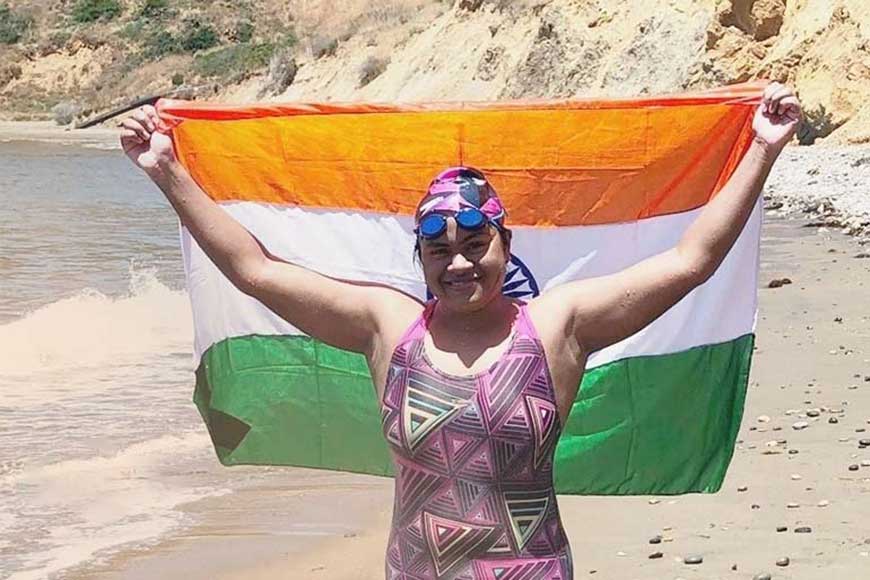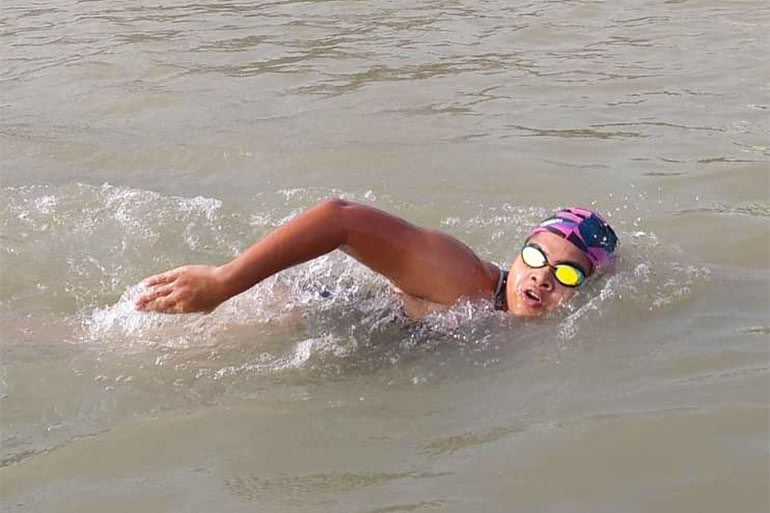Swimming Against the Tide: Sayani Das, The First Indian Woman to Swim Five Oceans – GetBengal story

Oife has not been easy for Sayani Das, a resident of Kalna, or Ambika Kalna, the 'City of Temples' in East Burdwan district. Harassed for practicing in local ponds, Das’s unwavering resilience has led her to victory. It certainly takes courage to swim 44 miles at a stretch, battling against dangerous waves, freezing temperatures, and lethal aquatic animals to cross five of the ‘Ocean Seven’ and earn the nickname ‘Jalpari’ (mermaid).
The Oceans Seven is a marathon swimming challenge, devised in 2008 as the swimming equivalent of the Seven Summits mountaineering challenge. It comprises the North Channel, the Cook Strait, the Molokaʻi Channel, the English Channel, the Catalina Channel, the Tsugaru Strait and the Strait of Gibraltar.
Das was seven when she started swimming and participated in a 10-kilometre swimming competition across the Ganga River, and that was just the beginning. There was a time when orthodox locals barred her from practicing in the ponds because she wore body-hugging swimming costumes in public. However, undaunted by hurdles, she continued to train.

Now she has become the first Indian woman to swim the Irish North Channel and the first Asian woman to have crossed five of the ‘Ocean Seven.’ In 2018, Sayani was awarded the state government's Khelashri special award, which included a cash prize of Rs. 3 lakh. She also received the 'Mother Teresa International Award' for her outstanding achievements.
On August 30 this year, the 23-year-old scaled a new height in Indian aquatic sports and carved a permanent place in the Hall of Fame of Marathon Swimming with her conquest of the North Channel. Sayani achieved the feat in 13 hours, 22 minutes, braving the biting cold, inexorable waves, and challenges from jellyfish and other harmful aquatic habitats.
The North Channel is bound by Northern Ireland to the west, Scotland to the east, the Isle of Man to the south, and the Atlantic Ocean to the north. The swim across the middle of the channel between Northern Ireland and Scotland is among the world's most challenging marathon swims. The North Channel is considered to be the toughest of the Ocean Seven. The weather is freezing, and the water temperature even during the summers is around 12 to 15 degrees Centigrade. The North Channel has stumped countless swimmers. Widely regarded as the hardest or most gruelling sea swim in the world, it is characterised by unusual swimming conditions, including sudden and unpredictable weather changes. Until now, only 115 people (including Das) have successfully made it across. Swimming across such waters for a long duration requires special acclimatisation and training, over and above the experience of marathon open-water swimming.
Sayani took to the waters on August 30, Friday at 7:45 am (British time) and completed her expedition at 03:00 IST (Indian Standard Time) on Saturday morning. Earlier in April this year, Das swam across the Cook Strait Channel in New Zealand. Motion sickness is certainly a factor here, and the water temperature is about 16 °C. Dolphins are common, and there are stories of dolphins protecting swimmers from shark attacks.
Sayani started her Oceans Seven (O7) conquest in 2017 when she was 18. She first set her eyes on crossing the English Channel between Great Britain and France, referred to as the ‘Everest’ of swims. This 22-mile stretch is one of the busiest shipping lanes in the world, with over 500 cargo ships crossing the channel every day. It also has the biggest tidal shifts in the world and is notorious for its strong currents. The water is cold—around 16°C—and hypothermia is a real danger.
Das had to conquer several obstacles that challenged her from the start. She required huge financial support to fulfil her dream. Her father, Radheshyam Das, a retired schoolteacher, had to mortgage their ancestral house to raise funds for the journey to the UK. She had to arrange for Rs 13 lakh herself.
Not only that, she also faced trouble with her visa, which was rejected multiple times before the final issuance.
She reached Great Britain in late July. In her first test swim, she was astounded to discover the temperature of the English Channel water. It was 12 degrees Celsius. After a couple of practice sessions, she was allotted a tentative date for her swim. However, on the scheduled date, the weather turned foul and the choppy waters made swimming impossible. The authorities cancelled the date, but Sayani was determined to complete her task. She went there on a tight budget and could not afford to delay. She pleaded with the authorities to allow her, but they were fearful of risking the life of a swimmer when there were previous records of accidents and fatalities. However, Sayani’s persistence paid off, and the authorities relented.

Swimming the channel was a daunting task. She had to deal with big swells and powerful winds. Jellyfish attacks added to her discomfort and pain, and by night, the temperature fell drastically. There were times when she was exhausted and wanted to give up, but her father and the boat instructor persuaded her to keep swimming because if at that point she stopped moving her hands, hypothermia would occur, leading to cardiac arrest. She remembered her hero and inspiration, legendary swimmer Masidur Rahaman Baidya, who was the world's first physically handicapped swimmer to swim across the English Channel. She finally completed the 33.5 km stretch from England to France on July 26-27, 2017 in 14 hours and 8 minutes.
After the conquest of the English Channel, Das did not stop. On 24 February 2018, she completed the 19.7 km Rottnest Channel in Western Australia in 6 hours 42 minutes. On 8 June 2019, Das swam across the 32.3 km crossing of the Catalina Channel from Santa Catalina Island to Southern California in 12 hours, 46 minutes. This channel features strong winds and fierce currents, and swimmers usually encounter large marine life, including migrating whales and dolphins. It is comparable to the English Channel in terms of the physical and mental challenges to swimmers.
In 2022, she created history by being the first female swimmer not only from India but also from the Asian continent to win the 28-mile-long Molokai Channel in Hawaii. The water is warm but features brisk winds and heavy currents. There are dolphins here, but also more aggressive marine animals like sharks.
Das is now aiming to cross the 12-mile-long Tsugaru Strait in Japan and the Strait of Gibraltar between Spain and Morocco and achieve the distinction of crossing all the channels in the ‘Ocean Seven’. The Tsugaru Strait is a deep-water channel, approximately 12 miles wide. Swimmers face extraordinarily strong currents flowing from the Sea of Japan to the Pacific Ocean. There are also occasional sections of cold water that flow up from the depths of the sea. Marine life is abundant, and swimmers are faced with blooms of squid (especially at night), sharks, and deadly snakes. The Strait of Gibraltar is one of the shorter crossings with a distance of 8 miles, but with unpredictable weather conditions, heavy freight ship traffic, high winds, and an eastern flow of water with an average of 3 knots (5.5 km per hour), this is an extremely difficult crossing.
‘Jalpari,’ a documentary film on her expeditions, was made by S.N. Films and won Best Documentary Film at the Student World Impact Film Festival (SWIFF) 2023, held at Waldwick, New Jersey (USA). Her autobiography, ‘Against the Tides,’ is soon to be released in Bengali. The book narrates her arduous journey as a female swimmer who was not only swimming against the tides but also battling against the perilous odds of life.










